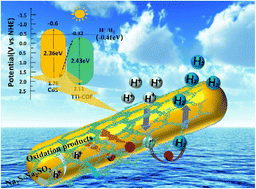Growing COFs in situ on CdS nanorods as core–shell heterojunctions to improve the charge separation efficiency†
Abstract
CdS has been widely used in photocatalytic water splitting due to its advantages of easy excitation by visible light and low cost. However, the applications of CdS are limited by photocorrosion and the rapid recombination of photogenerated electron–hole (e−–h+) pairs. Herein, protective COF (covalent organic framework) shells were grown in situ on the surface of functionalized CdS nanorods to form CdS@COF core–shell heterojunctions for high-performance photocatalytic H2 evolution. The CdS@TTI-COF-60 heterostructures provide the highest H2 production activity of 2851.7 μmol g−1 h−1 under visible light without a cocatalyst, which is 8- and 457-fold that of CdS and TTI-COF, respectively. The dramatic improvement in photocatalytic performance can be attributed to the appropriate energy band structures and the covalent bonding (C![[double bond, length as m-dash]](https://www.rsc.org/images/entities/char_e001.gif) N) between the TTI-COF shells and CdS nanorods, which facilitate the construction of a built-in electric field at the heterojunction interface and accelerate the separation of charge carriers. Specifically, the h+ in the VB of CdS were rapidly consumed by the e− in the CB of TTI-COF, which not only greatly improves the redox ability of CdS@COF but also inhibits the corrosion of CdS by the h+. The strategy of the in situ growth of protective shells provides a general route to construct heterojunctions between COFs and semiconductors and provides guidance for the development of high-performance Z-scheme heterojunction-based photocatalytic hydrogen production systems.
N) between the TTI-COF shells and CdS nanorods, which facilitate the construction of a built-in electric field at the heterojunction interface and accelerate the separation of charge carriers. Specifically, the h+ in the VB of CdS were rapidly consumed by the e− in the CB of TTI-COF, which not only greatly improves the redox ability of CdS@COF but also inhibits the corrosion of CdS by the h+. The strategy of the in situ growth of protective shells provides a general route to construct heterojunctions between COFs and semiconductors and provides guidance for the development of high-performance Z-scheme heterojunction-based photocatalytic hydrogen production systems.

- This article is part of the themed collection: Sustainable Energy & Fuels Recent HOT Articles


 Please wait while we load your content...
Please wait while we load your content...